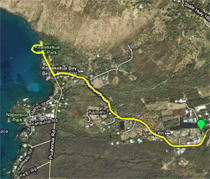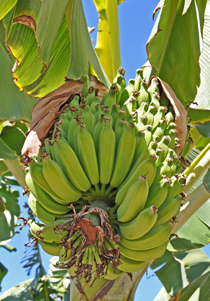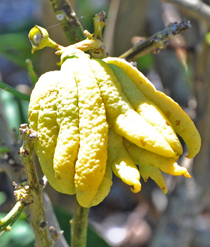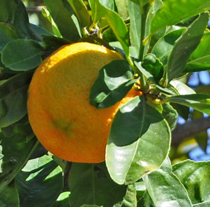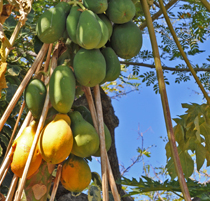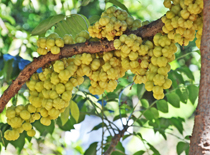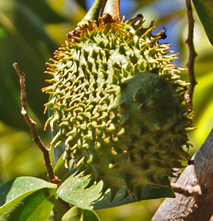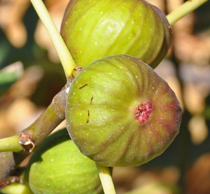December 6, 2024. I love walking and hiking in Hawai’i. I was mesmerized by the lava at Kilauea. Enchanted at the summit of Mauna Kea. But I’ve been really concerned about bananas. For a while.
So I was relieved and excited to find the Kona Pacific Farmers Cooperative and their experimental Kona Coffee and Fruit Garden. Where they’re growing dozens of varieties of bananas. And dozens of exotic fruits I’ve never heard of.
Today’s Walk? C’mon, let’s walk and talk at the same time.
It’s all about crop diversity and sustainability. The opposite of “monoculture”, the industrial agriculture practice that chooses one variety of something over all others. Grows that and only that variety because it travels better, has longer shelf life and maximum profitability. Until something goes wrong and wipes out that variety.
Banana extinction?
Maybe not. But it’s happened before. In the early 1900s, the commercially dominant banana variety was the Gros Michel. Until a fungus, the Panama Disease, wiped out banana plantations everywhere. The banana business almost went out of business. But a Chinese varietal, the Cavendish, was resistant to the fungus. United Fruit and others thought consumers would reject it because it didn’t taste so good. But they had no choice. They started growing and selling them.
So today we all eat Cavendish bananas. Americans average 26 pounds per year per person. I don’t think I’ve ever eaten a Gros Michel banana. And I’ve never been to a banana tasting. But when I was doing anthropological field research on a tiny island in New Guinea, I ate at least a dozen kinds of bananas. Every one better-tasting than a supermarket banana. Some so sweet they were almost too sweet to eat. Big, medium, small and tiny bananas. Yellow, green, red and blue bananas.
Maybe the Cavendish is inferior. But I’ve been enjoying them for breakfast since I was old enough to eat solid food. Now, in some places, they’re under attack by a blight that may be the beginning of their end. Or not. Or maybe it’ll be the beginning of better bananas. Like the ones they’re growing at the Kona Pacific Farmers Coop.
If you make it to the Big Island, come visit this place. It’s not big, but you can walk around and be fascinated for at least an hour. Even if you stroll around casually, you’ll burn 300 calories. That’s three bananas. Let’s do the math. A 20-minute walk burns a banana.
And that banana probably helps you burn fat. A study in The Journal of Nutrition shows exercise after a high-fiber, low glycemic index breakfast (granola, yogurt, fruit) burned twice as much fat per hour as exercise following a high glycemic breakfast (cornflakes, milk, white bread, jam).
Get ’em while you can. Eat a banana before your morning walk. Here at the Kona Coffee and Fruit Garden, you can get a pretty good cup of coffee with it. And after you’ve seen every fruit varietal they’re growing, you can take a great walk. All the way down Lower Napoopoo Road, past dozens of small farms, to Kealakekua Bay. Where you can take a swim with dozens of spinner dolphins spiraling in and out of the water. Just for fun.
Two and a half miles round trip. I made a big, detailed Google Map to show you the way. Downhill there. Uphill on the return. Another five or six hundred calories.
Hard to imagine a nicer morning. Not psychedelic, like walking on new lava. Not sci-fi, like walking around the summit of Mauna Kea. Until you think, yes, we might have no bananas, one day.
Every Thing is Everything
“Although previous studies have found enhanced mood for up to an hour after exercise, this study found benefits for up to 12 hours following activity, compared to the resting group…Test subjects performed exercise at 60 percent of aerobic capacity, indicating that moderate-intensity exercise – like walking or light cycling – is enough to boost mood.”
(“Boost Your Mood at Least Half the Day with Physical Activity”, American College of Sports Medicine, 2009)
“ … exercise has a benefit of reducing risks of cardiovascular disease and diabetes, beyond that produced by weight reduction alone.” (from the National Heart, Lung and Blood Institute of NIH. Their Guide to Physical Activity lists many examples of “moderate physical activity”, including “Raking leaves for 30 minutes” and “Walking 2 miles in 30 minutes”.
“Like muscle, bone is living tissue that responds to exercise by becoming stronger… The best exercise for your bones is the weight-bearing kind, which forces you to work against gravity. Some examples of weight-bearing exercises include weight training, walking, hiking, jogging, climbing stairs, tennis, and dancing.” (National Institutes of Health, January 2009)
Put your money where your mouth is
Buy the healthy, tasty stuff that was grown to be eaten – not the stuff engineered to be shipped, stored and marketed.
“In 1982, farmers captured 34 percent of what consumers paid for fresh vegetables at retail food stores; by 2004, these farm shares had declined to 19 percent.” (Economic Research Service of the USDA) The other 81% goes to processing, packaging, shipping and marketing. So put your money where your mouth is: pay a farmer and buy local whenever possible.
Click to see the big, detailed Google Map I made for you.
Top to bottom: Maoli Hai banana; Buddha’s Hand; Rangpur Lime; Giant Passion Fruit; Otaheite Gooseberry; Soursop; Brown Turkey Fig

